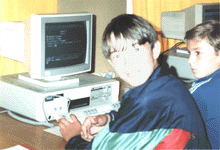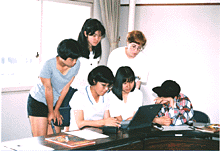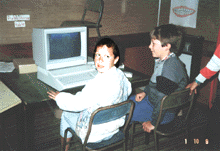



The number of elementary, junior high, and high schools that are forming electronic sister-school ties on the Internet is rising. The schools not only exchange e-mail with sibling institutions in other countries but also undertake joint projects, such as creating picture storybooks and holding electronic forums on such issues as the environment.
A Hit with Students
The Electronic Sister School Project is the creation of the Asia Pacific Interactive Communication Network (APICNET), established by the Association for Promotion of International Cooperation to encourage participation in communication networks and foster international cooperation and understanding.
The number of elementary, junior high, and high schools in the program has risen to 47 in Japan and 79 in 10 other countries--Australia, Britain, Canada, China, Finland, New Zealand, Norway, Russia, South Korea, and the United States.
The reaction of the students has been very positive. "I thought it would be difficult to become friends with people from other countries," one student said, "but through the program I've been able to expand my circle of friends, and we've gotten to know each other's culture better." Other students voiced the hope that more people would participate in the exchanges and felt that computer communication has made their sister schools feel they were located close by.
The experience has also been eye-opening for many. "When I found out how seriously American high school students were thinking about problems like AIDS and gun control, I thought that we had to begin to think about such issues as well," a student said.
Cross-Cultural Stories
One big feature of the Electronic Sister School Project is that students of different countries can learn together regardless of the differences in their countries' histories, cultures, and value systems. Electronic exchanges transcend boundaries of space and time, and it is hoped that they will foster international understanding and cooperation in the future.
In 1994 second graders from Rinkan Elementary School in Yamato, Kanagawa Prefecture, jointly produced picture storybooks with their counterparts in Lakeview Elementary School in Nebraska, U.S.A. The students split the responsibility for writing the story; when the Japanese students wrote the first half, it was up to the Americans to write the second half. Then they would work together on the illustrations. The stories were exchanged by e-mail and illustrations by fax. During the year, the students completed seven storybooks with such titles as "Kangaroo's Story," "The Blue Whale," and "The Penguin's Adventure"
Students attending Chofu Junior High School in Shimonoseki, Yamaguchi Prefecture, had been carrying out classroom debates on environmental problems for a number of years. Because environmental issues affect all countries around the globe, they decided to begin exchanging opinions and information with their counterparts in foreign countries, including Britain, Canada, Norway, and the United States. The views that were exchanged with the American students were collected into a booklet and published under the title "The Bridge in the Future: Crossing the Border."
Student Declaration for Global Partnership
In a separate program organized by APICNET called "What's Japan, What's America," five Japanese and U.S. high schools explored bilateral perception gaps, starting with a questionnaire survey in the fall of 1993, and leading to an analysis of the responses, questions and answers regarding Japanese and U.S. society, and culminating in discussions about global issues.
These discussions were organized by theme--AIDS, gun control, rice, and world peace--and compiled into the "Joint Declaration of the Global Partnership of Japanese and American High School Students." The declaration was issued as a press release and sent via e-mail to then Japanese Prime Minister Morihiro Hosokawa and U.S. President Bill Clinton.
(The above article, edited by Japan Echo Inc., is based on domestic Japanese news sources. It is offered for reference purposes and does not necessarily represent the policy or views of the Japanese Government.)